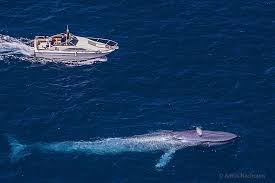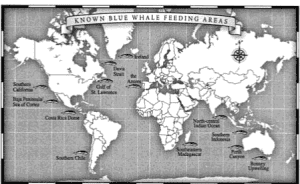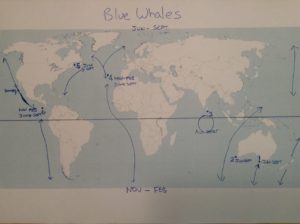It is estimated that the world population of blue whales may be as low as 20000 Blue whales are found in all oceans except the Arctic. They generally migrate seasonally between summer feeding grounds and winter breeding grounds, but some evidence suggests that individuals in certain areas might not migrate at all.Antarctic blue whales are generally larger than other blue whale subspecies. For example, in the North Atlantic and North Pacific, blue whales can grow up to about 90 feet and are over 100,000 pounds, but in the Antarctic, they can reach up to about 110 feet and weigh more than 330,000 pounds. Like many other baleen whales, female blue whales are generally larger than males.
BEST PLACES TO SEE BLUE WHALES
True Blue Whales
1. North shore of the Gulf of Saint Lawrence and in the Saint Lawrence estuary , Tadousac. June, to September. Occasionally Gulf of Maine.
2. The Azores. year round, (northern populations NOV-FEB and ?southern populations JUN-SEPT.
3 Iceland June July August.
4. Monterey Bay and Alaska in the summer June, July August.
5. Southern California, starting as early as March and April, with the peak between July and September. More whales have been observed close to shore along with fin whales.
6. Sea of Cortez Feb march.
7. Costa rica year round. May be Southern Pacific in June to Sept and North Pacific Nov to Jan.
8. Along the coast of Chile and Peru near the coast, occasionally making mixed groups with fin, sei, and Bryde's whales.
9.Gulf of Corcovado Chile in Austral Summer.feeding Galapagos in winter breeding Chiloe Island in the Gulf of Corcovado (Chiloé National Park), where 326 blue whales were spotted in 2007. In this regions, it is normal for blue whales to enter Fiords. Whales also reach southern Los Lagos, such as off Caleta Zorra, live along with other rorquals.
10. New Zealand Bay of islands in the winter, whales have been seen in many areas close to shore, most notably around the Northland coast, in the Hauraki Gulf and the Bay of Plenty, off South Taranaki Bight, in Cook Strait and off Kaikoura
Pygmy Blue Whales
1. Portland Australia The Bonney Upwelling, beyond the end of the Great Ocean Road.
Each year around the beginning of November, cold water from great depths funnels through underwater canyons, welling up and spilling across the continental shelf clear to the shores of what is known as the Bonney coast between the towns of Portland in south-west Victoria and Robe in the south-east of South Australia. Spotted from November to April. Cape Nelson and Cape Bridgewater are two of a few places in the world where Blue Whales can be seen feeding from land. Kangaroo Island.
2. The Perth Canyon Dec-April also Geographe Bay
3. Indonesia , passing through the Timor straits near Alor Island and Ataúro Island, located 20km north of Dili pass the Savu sea right at the doorstep of the island of Lembata ( May time going into the Banda Sea. Spending winter there and heading back down the WA coast in October.
4. Sri Lanka year round.
Blue Whales are found in all oceans of the world. Mostly feeding at the poles or higher latitudes during their respective summers and wintering in the tropics.

Distribution and Migration
It appears that there are 7 distinct populations of True Blue Whales and 3 of Pygmy Blue Whales
True Blue Whales
1. North Pacific The largest known population consisting of about 2,800 individuals migrates from Alaska to Costa Rica, but is most commonly seen from California in summer . Infrequently, this population visits the northwest Pacific between Kamchatka and the northern tip of Japan.
2.North Atlantic W off Greenland, Newfoundland, Nova Scotia and the Gulf of Saint Lawrence. This group is estimated to total about 500.
3.North Atlantic E is spotted from the Azores in spring to Iceland in July and August; it is presumed the whales follow the Mid-Atlantic Ridge between the two volcanic islands. Beyond Iceland, blue whales have been spotted as far north as Spitsbergen and Jan Mayen, though such sightings are rare. Scientists do not know where these whales spend their winters. The total North Atlantic population is estimated to be between 600 and 1,500. Off Ireland, the first confirmed sightings were made in 2008, since then Porcupine Sea-bight has been regarded as a prominent habitat for the species along with fin whales.
4.Southern Pacific W spend Southern Summer (Nov to March) in the Antarctic and migrate North to Australia, New Zealand and even as far as The Cook islands in June to Sept.
5. Southern Pacific E spend Southern Summer (Nov to March) in the Antarctic Gulf of Corcovado (326 blue whales were spotted in this regions, it is normal for blue whales to enter Fiords. Whales also reach southern Los Lagos, such as off Caleta Zorra) along with other rorquals.and and migrate North along Chilie and Peru to spend June to Sept off Galapagos, Costa rica also adjacent to Easter Island and Isla Salas y Gómez, where possibilities of undiscovered wintering grounds have been considered.
6. South Atlantic E spend Southern Summer (Nov to March) in the Antarctic and migrate north along the West African Coast such as off Angola and Mauritania, and at least some whales around Iceland are known to migrate to Mauritania.
7. South Indian Ocean spend Southern Summer (Nov to March) in the Antarctic and migrate north Madagascar and Australia in the winter
Pygmy Blue Whales
1.Sri Lankan Pygmy Blue Whales A permanent population off Sri Lanka occasionally sighted off Oman, Maldives adjacent to Arabian Sea, including from Gulf of Aden, Persian Gulf, coasts of Bay of Bengal including Bangladesh to Myanmar, and within the Strait of Malacca.Trang off Thailand.
2. West Australian Pygmy Blue Whales migration from Portland In the Southern Summer (Nov to Feb) past the Perth Canyon (March to April) whales hugged the western coast within 100km to North West Cape, whales covered some 22 km per day travelled within about 100 km of the west Australian coastline throughout March and April, until they reached the North West Cape then took a line for Timor and into the Banda and more northern Molucca seas to Indonesia in the Southern Winter (May to October) whales regularly appear off Bohol, north of the Equator
3. Madagaska Pygmy Blue Whales 424 pygmy blue whales were in a small area south of Madagascar (the Madagascar Plateau)


Where They Live
Blue whales are found in all oceans except the Arctic. They generally migrate seasonally between summer feeding grounds and winter breeding grounds, but some evidence suggests that individuals in certain areas might not migrate at all. Information about distribution and movement varies with location, and migratory routes are not well known. In general, distribution is driven largely by food availability—they occur in waters where krill are concentrated.
In the North Atlantic Ocean, their range extends from the subtropics to the Greenland Sea. Blue whales have been sighted in the waters off eastern Canada and in the shelf waters of the eastern United States.
Along the West Coast of the United States, eastern North Pacific blue whales are believed to spend winters off of Mexico and Central America. They likely feed during summer off the U.S. West Coast and, to a lesser extent, in the Gulf of Alaska and central North Pacific waters.
Blue whales with young calves are regularly observed in the Gulf of California (Sea of Cortez) from December through March. It is believed that this area is an important calving and nursing area for the species.
In the northern Indian Ocean, there is a "resident" population. Blue whale sightings, strandings, and acoustic detections have been reported from the Gulf of Aden, Arabian Sea, and across the Bay of Bengal. The migratory movements of these whales are largely unknown but may be driven by oceanographic changes associated with monsoons.
In the Southern Hemisphere, Antarctic blue whales occur mainly in relatively high latitude waters south of the "Antarctic Convergence" and close to the ice edge in summer. They generally migrate to middle and low latitudes in winter, although not all whales migrate each year. Pygmy blue whales (Balaenoptera musculus brevicauda)—a subspecies—are typically distributed north of the Antarctic Convergence and are most abundant in waters off Australia, Madagascar, and New Zealand. An unnamed subspecies of blue whale is found in the southeastern Pacific Ocean, particularly in the Chiloense Ecoregion, and migrates to lower latitude areas, including the Galapagos Islands and the eastern tropical Pacific.
